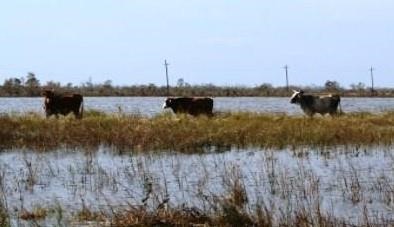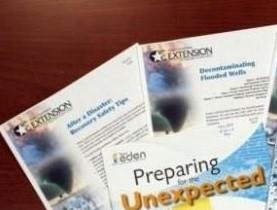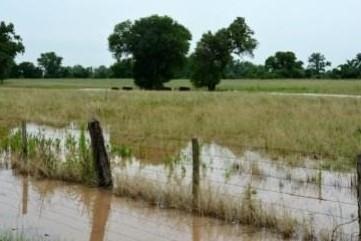Although personal safety is always of primary concern, farmers and ranchers in Texas should also have an emergency response plan in place that protects all livestock and other large animals on their property.
“Emergency preparedness is important for all animals, but especially for livestock because of their size, feed requirements, and shelter and transportation needs,” said Monty Dozier, Texas A&M AgriLife Extension Service program director for disaster assessment and recovery, Bryan-College Station. “In Texas, an extremely likely emergency scenario that might affect livestock is flooding, either due to excessive rainfall or rain and tidal surge from a tropical storm or hurricane.”

Cattle on high ground after a hurricane tidal surge.
Flooding can be from flash floods that occur quickly due to intense rainfall or develop over time, as with tropical depressions, storms and hurricanes. It can also result from another unexpected occurrence, such as a failed dam upstream of a farm or ranch.
Identify resources
“The emergency plan should include phone numbers of resources you may need before, during and after the emergency,” Dozier said. “This would include contact information for employees, neighbors, veterinarians, animal shelters, transport services and feedstock providers. You should also have the number for the local poison control center and your local AgriLife Extension office.”
Also, he said, be sure to include contact information for out-of-area resources in the event local resources become overwhelmed.

There are many disaster preparation and recovery materials available on the Texas EDEN website.
Dozier said practical information on preparing livestock for a disaster can be found on the Texas Extension Disaster and Emergency Education Network, Texas EDEN, the AgriLife Extension Bookstore and in e-book format.
Steps to prepare, protect livestock
Jason Cleere, Ph.D., AgriLife Extension beef cattle specialist in the Department of Animal Science, in the College of Agriculture and Life Sciences, Bryan-College Station, said some of the main steps to take toward ensuring the safety and safe return of livestock include: — Adequate animal identification. Livestock should have visible identification numbers, even if there are no plans to transport them from the property.
“Floods often drive livestock to seek shelter, and they become lost or end up in a neighbor’s pasture,” Cleere explained. “Unfortunately, some people also take advantage of the opportunity and steal displaced livestock.”
— Restrict access to dangerous areas. W?hen necessary, move livestock to higher ground and deny access to flood-prone pastures, barns or exterior structures. Many livestock drown because they refuse to leave flooded shelters. Also, keep livestock from reentering potentially dangerous areas.
“Moving livestock to higher ground will also allow you to provide them better care and help alleviate any potential foot and skin problems they may get from the flooding,” Cleere said.
— Continue to supply food and water. ?During floods, livestock still need food and clean water. Emergency preparedness should include contingency options for feeding and watering animals.
“Hay is the most important feed source for stranded or displaced cattle,” Cleere said. “It’s acceptable for animals to eat clean hay, even if it’s wet, especially if that’s the best option available. However, don’t give livestock moldy feed as it may contain toxins.”
He also warned against giving livestock any water that may have been contaminated from the flooding.
“Some resources may become inaccessible or contaminated by floodwaters,” he said. “In some cases, it may be necessary to truck in water to livestock holding areas.”
— Remove potential contaminants. ?Floodwaters often contaminate soils, animal feed and fresh water sources by carrying chemicals, fertilizers, trash and other debris from their original containers and locations.
“Some ways to protect an animal from potential contaminants include labeling hazardous materials and placing them in a safe location along with moving chemicals, fuels fertilizers and other contaminants to higher ground and checking the containers for leaks,” Cleere said. “You should also maintain an inventory of all hazardous substances that could be leaked during a flood and remove any buried trash that could leach into crops, feed supplies, water sources and pastures. Finally, be sure to secure or remove anything that could become floating debris, including trailers, propane tanks, boats and feed troughs.”
— Check for fire/electrical hazards. Remove all fuels from the vicinity of barns and turn off all electrical power to barns, buildings and other structures that house livestock until the threat of flooding has subsided.
“If available, use gasoline or diesel generators that can be transported away from the area when not in use,” Cleere said.
Dozier added that during extensive flooding AgriLife Extension will often stage strike teams at various animal supply points around affected areas. These supply points serve as staging areas to receive hay and feed donated by farmers and ranchers, as well as industry and commodity association partners, throughout the state.
Livestock after a flood
The aftermath of flooding can also leave hazards that could lead to animal injury or death, Dozier said.
“Some possible hazards include contaminated food and water; standing or stagnant water in which mosquitoes can breed; animal carcasses; sick, diseased or displaced animals; damaged gates and fences; weakened structures; and eroded or unstable creek beds,” he said. “After a flood it is important to inventory all livestock and identify any missing animals, remove potentially dangerous objects from pastures and quickly repair any damaged fences or gates.”

Brazos County field after a flood.
Dozier said removing objects from pastures protects more than livestock.
“It also protects farm workers and machinery from being injured or damaged when mowing pastures that have grown over and hidden these objects,” he said.
Joe Paschal, AgriLife Extension beef cattle specialist, Corpus Christi, said as soon as it is safe, livestock owners should check on the condition of their animals,
“It is best to move them out of flooded areas and into dry or covered areas if possible, then check them for injury and render any necessary first aid as able until a veterinarian can be found,” Paschal said. “If an animal has an injury, clean the wound and dress it with a topical antibiotic, and cover it with a bandage or gauze if available. Then contact your vet and provide a full description of the injury, so your vet can prioritize the treatment of your animal.”
Paschal said animals that have not been able to eat for one or more days should be given a little feed over the first few days, then gradually increase the ration over a week’s time.
“Producers should also check their animals for signs of illness, especially a secondary respiratory disorder like pneumonia,” he said. “Listen for coughing or hard breathing and look for non-clear mucus running from the nose. Later you might notice crusty eyes and a lowered head. You’ll want to separate these animals and get them treatment as soon as possible.”
He also noted foot rot or leptospirosis is another typical problem with cattle after flooding and can even occur after only an extended rainfall.
“It’s also important to make sure all livestock vaccinations are current and to apply insect repellents to protect livestock from what will likely be increased mosquito and fly populations,” Paschal said.
Dozier said for farmers and ranchers, protecting livestock from the hazards of flooding and other natural disasters and emergencies is essential to help ensure the continued success of their operations.
“The recent and more distant past have shown us there are any number of natural or manmade disasters or emergencies that can potentially affect an agricultural enterprise,” he said. “Replacing livestock can be frustrating, time-consuming and expensive proposition, so this is another instance where some preparation in the short term can save a lot in the long term.”
Source : tamu.edu